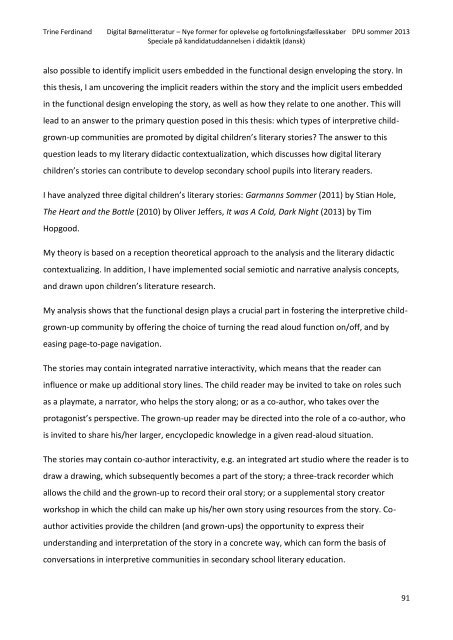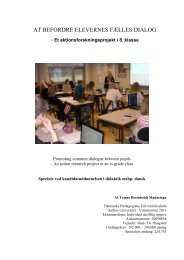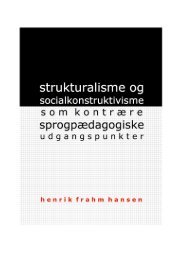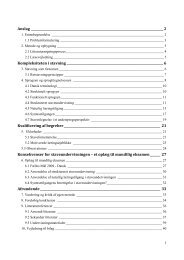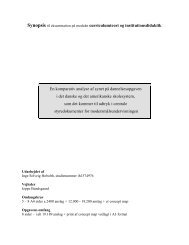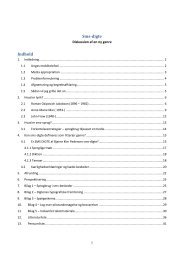Digital Børnelitteratur Nye former for oplevelse og ...
Digital Børnelitteratur Nye former for oplevelse og ...
Digital Børnelitteratur Nye former for oplevelse og ...
Create successful ePaper yourself
Turn your PDF publications into a flip-book with our unique Google optimized e-Paper software.
Trine Ferdinand <strong>Digital</strong> <strong>Børnelitteratur</strong> – <strong>Nye</strong> <strong><strong>for</strong>mer</strong> <strong>for</strong> <strong>oplevelse</strong> <strong>og</strong> <strong>for</strong>tolkningsfællesskaber DPU sommer 2013<br />
Speciale på kandidatuddannelsen i didaktik (dansk)<br />
also possible to identify implicit users embedded in the functional design enveloping the story. In<br />
this thesis, I am uncovering the implicit readers within the story and the implicit users embedded<br />
in the functional design enveloping the story, as well as how they relate to one another. This will<br />
lead to an answer to the primary question posed in this thesis: which types of interpretive child-<br />
grown-up communities are promoted by digital children’s literary stories? The answer to this<br />
question leads to my literary didactic contextualization, which discusses how digital literary<br />
children’s stories can contribute to develop secondary school pupils into literary readers.<br />
I have analyzed three digital children’s literary stories: Garmanns Sommer (2011) by Stian Hole,<br />
The Heart and the Bottle (2010) by Oliver Jeffers, It was A Cold, Dark Night (2013) by Tim<br />
Hopgood.<br />
My theory is based on a reception theoretical approach to the analysis and the literary didactic<br />
contextualizing. In addition, I have implemented social semiotic and narrative analysis concepts,<br />
and drawn upon children’s literature research.<br />
My analysis shows that the functional design plays a crucial part in fostering the interpretive child-<br />
grown-up community by offering the choice of turning the read aloud function on/off, and by<br />
easing page-to-page navigation.<br />
The stories may contain integrated narrative interactivity, which means that the reader can<br />
influence or make up additional story lines. The child reader may be invited to take on roles such<br />
as a playmate, a narrator, who helps the story along; or as a co-author, who takes over the<br />
protagonist’s perspective. The grown-up reader may be directed into the role of a co-author, who<br />
is invited to share his/her larger, encyclopedic knowledge in a given read-aloud situation.<br />
The stories may contain co-author interactivity, e.g. an integrated art studio where the reader is to<br />
draw a drawing, which subsequently becomes a part of the story; a three-track recorder which<br />
allows the child and the grown-up to record their oral story; or a supplemental story creator<br />
workshop in which the child can make up his/her own story using resources from the story. Co-<br />
author activities provide the children (and grown-ups) the opportunity to express their<br />
understanding and interpretation of the story in a concrete way, which can <strong>for</strong>m the basis of<br />
conversations in interpretive communities in secondary school literary education.<br />
91


